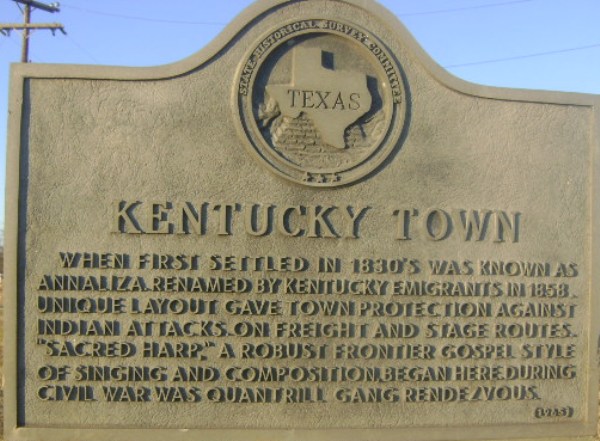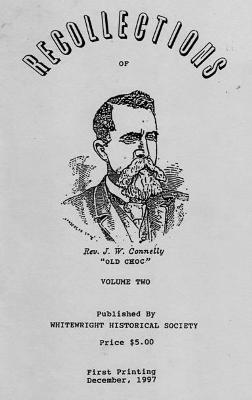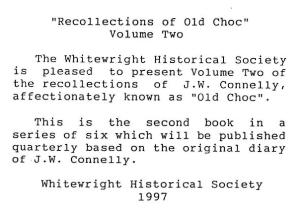 1850s The first gin was built by Henry Dunaway. He sold it to Miller Earnheart who ran it for a year or two until it was destroyed by fire. The next gin was built by J. A. Hamilton and, later, owned by Duro Austin. Several attempts were made to establish saloons in the town but it is said, to its honor, that Kentuckytown was always noted for the industry, sobriety and purity of her citizens. The Christians, who were then called Campbellites, built a church and had a large membership. But they made the mistake of letting the building be used for school purposes. Through carelessness, it was destroyed by fire in 1873. The building of another church house began in 1879. However the church was abandoned by the members when the building was about half complete. Robert Moore built the first, and only, hotel. He kept boarders and entertained the traveling public until the end of the Civil War. He returned to Illinois, his native state. 1852 The town was laid out and known by the name Ann Eliza and the church was named "Pleasant Hill." 1853 In the spring, business houses and residents went up quickly. In the summer, Col. J. M. Head and Dr. Lazarus Powell established a drug store on the south side of the square. They sold out to Dr. O. P. Heiston, who came to Texas from Kentucky in the winter of 1853. Powell went back to his native state. Head engaged in farming near town. He owned land now owned by Mr. Crumpley and Mr. Montgomery. He was a lawyer by profession but preferred the quiet, independent life of a farmer. In 1861 he was elected to the legislature from Grayson County and Collin County over Capt. John Howe. He died in Hillsboro while on his way to Austin. In the fall, Hugh L. White, of Jefferson, opened a dry goods store on the southeast corner of the square. He died in the spring of 1854. His remains repose in the almost forgotten cemetery on the Thomas Hamilton farm. Mr. Sears sold out to Ben and Samuel Savage and retired to his farm where he engaged in farming and stock raising until his death in 1881. He purchased 950 acres of land for which he paid one dollar and fifty cents per acre. For many years, Mr. Sears was an exemplary member of the Cumberland Presbyterian Church. The Savage brothers continued the mercantile business for many years. People rode on horseback or in wagons drawn by oxen. Ben thought a merchant should ride in a carriage and bought one from a man who recently came to Texas. One day, there came a violent wind from the north and carried the carriage, which stood in front of his store, rapidly down the street to the amusement of bystanders. The Savage brothers sold out to H. P. Dyer and Benjamin Ernest, who continued the business until the beginning of the Civil War. At that time, H. P. Dyer became a minister and devoted his time to preaching the gospel. Several years after the close of the war, he moved to Iowa. Benjamin Ernest enlisted in the Confederate service. He returned to his home in Kentuckytown and engaged in bee culture and poultry raising. He never married. He was a member of the Methodist Church. Dr. D. W. Light engaged in the saddle and harness business for several years. He closed his business and engaged in stock raising. After spending several years in the gold region of California, he returned to invest in cattle. 1854 James H. King and W. F. Petters bought the house and stock of goods from Dyer and Heiston. After about a year, they sold out to Robert and Wharton Inglish. A short time after Mr. King went out of business in Kentuckytown, he married Miss M. A. Jones and settled on his farm located seven miles northwest of Whitewright. After thirty years, he moved to Whitewright. His wife died in March 1895 and his youngest daughter, Mrs. W. R. Hoard, died in February 1900. He left three children - Dr. S. F. King of Sherman; W. H. King and Mrs. J. L. Branchford of Whitewright. A. L. Hamil, a New York native, established a business house at Sowel's Bluff on the Red River. He came to Kentuckytown in the spring of 1854 and built a large house on the northeast corner of the square where he sold goods for a year or two. He, then, went to Waco, Texas. He was succeeded by Col. J. R. Russell of Bonham,who conducted the business for one year, then sold his interest to the Inglish brothers. Dr. W. P. Head and Dr. R. D. King established a drug store on the south side of the square and associated themselves in the practice of medicine. In 1860, the partnership dissolved. Dr. King went to his farm five miles northwest of Kentuckytown and engaged in agriculture and the practice of medicine until failing strength and age caused him to retire. He, then, built a residence in Whitewright where he and his wife lived. After his wife died, he lived with his youngest daughter, Mrs. Pascal Head. Dr. Head enlisted in the Confederate army as a surgeon of the 16th Regiment of Texas and served until the end of the war. After the war, he resumed his practice until his death. His health began to fail in 1870 and he became too feeble to ride in a buggy. His patients came to his home for treatment. He died December 16, 1873. Dr. D. M. Ray, brother-in-law to Dr. Head, was the leading physician in town after Dr. Head's death and until Whitewright was established. He moved to Whitewright to practice. Dr. J. M. Mc___ settled in the town in the 1870s and married Miss Ida Ray. He practiced medicine in connection with a dry goods store for several years, then moved to Jacksboro. Mr. H. H. Harrison and Mr. William Bean came to Kentuckytown from North Carolina and built a mill run by an inclined wheel. After a few years, they sold the mill and Mr. Bean went to Farmington and built another one on a larger scale which he ran until after the close of the Civil War. Mr. Harrison went to Pilot Point where he built a mill and lived there until his death. The mill at Kentuckytown was kept in constant operation until after the close of the Civil War when it was destroyed by fire. 1855 The Baptists built an edifice in town which was the first of its kind erected west of Paris, Texas. There was not a school building so it was used for school purposes. The building was blown down in a violent storm in 1862. Prof. Cloyed was the teacher. When he felt the house begin to shake, he told the children to run out. He was standing near the door and stepped out and escaped but all the children were buried beneath the ruins. Florence Penn was killed instantly and Sallie Whaley died the next day. Ida Ray had her hip dislocated but suffered no serious injury from it. Mary Dyer was made a cripple for life. If it had not been for the strong oak seats, the debris would have killed every child. Miss Dyer married a man of her own name and still lives in her father's house a short distance from where the calamity occurred. 1857 Dr. James Scales bought the residence and business house of J.A. Drye. He engaged in the mercantile business as well as practicing his profession until his death in 1864. 1858 John Drye established a mercantile house on the southwest corner of the square. It was in operation until the outbreak of the Civil War. Civil War Era Every business house in Kentuckytown was closed during the Civil War except for that of F. W. Price. He continued his business on a small scale throughout the war. His noble wife, to whose wise counsel and cheerful cooperation he owed much of his success, died in 1871. Her death and his second marriage, which was an unhappy one, filled his heart with sorrow which he tried, in vain, to drown in an intoxicating cup. 1865 F. M. Dyer opened a dry goods/grocery store in the house formerly occupied by his brother until the fall of 1872 when it was destroyed by fire. He then engaged in farming, renting land until 1885 when he bought land in Hunt County, five miles south of Ladonia and lived there until 1898. He, then, moved to Trenton and engaged in farming. In the spring of 1904, cancer appeared on his neck and throat resulting in his death on August 6, 1904. 1866 Hendricks & Drapes came from Alabama to Kentuckytown and established a mercantile house. They continued in this business for a few years and, then, returned to their native state. William Everheart succeeded Hendricks and Draper. After a few years in the business, he sold out and was elected sheriff of Grayson County. C. W. Batsell built a large house on the northeast corner of the square and engaged in the mercantile business. About 1875, he sold out to J. W. Batsell and James Reeves, moved to Sherman and became a successful businessman. Batsell and Reeves continued a successful business until the MK&T was built to Whitewright. Kentuckytown was then the commercial center of that section of Grayson County. Batsell and Reeves believed that Whitewright would become important and moved the house and business to it. It was the first business house established in Whitewright. Mr. Batsell also moved his residence to Whitewright where he died in the 1890s. Elder Charles Carlton moved to Kentuckytown, bought property and converted it into a residence. He taught school in the Christian Church. In the following year, he sold the property and moved to Bonham where he established the Carlton College. 1870s Jim Lea bought the lot on which the house belonging to Mr. Dyer was burned. He built a house and opened a dry goods and grocery store, operating it until 1882. He, then, sold it and moved to Bells where he died in 1888. J. C. Sewell settled in Kentuckytown and engaged in the saddle and harness business. He opened a dry goods/grocery store for several years and then sold his interest to Thomas Parish. Mr. Sewel died in the 1900s. After his death, his family moved to Sherman. 1872 The Baptists built another house of worship northeast of the square and about fifty yards beyond the corporate limits of the town. They chose this site because it was near a well reported to have splendid water, located on the premises of a Mr. Mitchell, which he kindly gave to the church for the benefit of the people. When the deacon went to get the first bucket of water, he found in the well: one goat, two dogs, six tame cats, seven pole cats, ten rabbits, and snakes, frogs and bugs too numerous to mention; all in an advance state of decomposition. The deacon returned to the house with an empty bucket and never did a church-goer use the well again. I preached in that house as pastor for eighteen years and, then, accepted a call to Whitewright. The church continued to worship there for several years but the house was given up to bats and owls. It was sold to Duro Austin. When the railroad came to Whitewright, Kentuckytown declined for several years. "Now she seems to be taking on new life." Mr. Parrish has a large house filled with dry goods and groceries. The school house has been repaired and a flourishing school is taught there. The Baptist have recently completed a house of worship. Several residents have been erected. The Cotton Belt will, in the near future, build a depot. Thomas Brown and Peter McKenna were prominent grocery men until the town began to wane. Brown moved to Wise County. McKenna moved the business to Whitewright. On October 30, 1966 the historical plaque was unveiled during a special service as well as the Kentuckytown's historical marker placed at the intersection of Jefferson Street and State Highway 11.  The names of the community are recorded as Kentuckytown, Kentucky-town and Kentucky Town. The accepted historical name is Kentucky Town. 
 Kentuckytown History Towns Susan Hawkins © 2024 If you find any of Grayson CountyTXGenWeb links inoperable, please send me a message. |